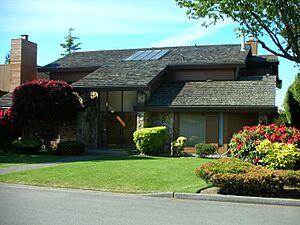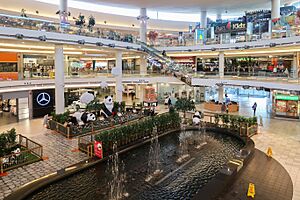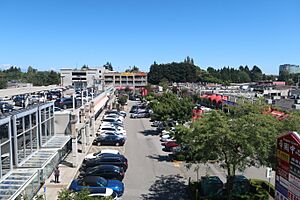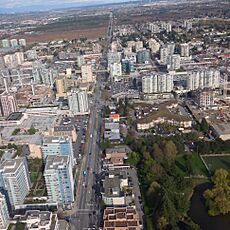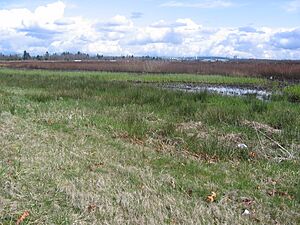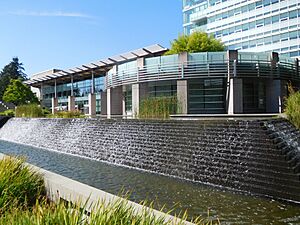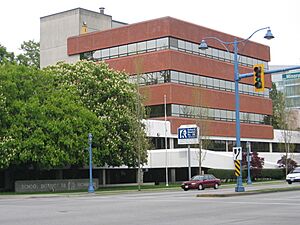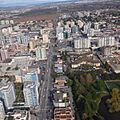Richmond, British Columbia facts for kids
Quick facts for kids
Richmond
|
|||
|---|---|---|---|
| City of Richmond | |||

Downtown Richmond from the SkyTrain
|
|||
|
|||
| Motto(s):
Child of the Fraser
Island City by Nature Better in Every Way |
|||
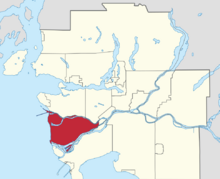
Location of Richmond in Metro Vancouver
|
|||
| Country | Canada | ||
| Province | British Columbia | ||
| Regional district | Metro Vancouver | ||
| Incorporated | 10 November 1879 (municipality status) | ||
| 3 December 1990 (city status) | |||
| Seat | Richmond City Hall | ||
| Government | |||
| • Type | Mayor-council government | ||
| • Body | Richmond City Council | ||
| Area | |||
| • Land | 128.87 km2 (49.76 sq mi) | ||
| Highest elevation | 12 m (39 ft) | ||
| Lowest elevation | 0 m (0 ft) | ||
| Population
(2021)
|
|||
| • Total | 209,937 | ||
| • Estimate
(2023)
|
229,781 | ||
| • Rank |
|
||
| • Density | 1,629.0/km2 (4,219/sq mi) | ||
| Demonym(s) | Richmondite | ||
| Time zone | UTC−08:00 (PST) | ||
| • Summer (DST) | UTC−07:00 (PDT) | ||
| Forward sortation area |
V6V – V6Y, V7A – V7C, V7E
|
||
| Area codes | 604, 778, 236, 672 | ||
| Highways | |||
Richmond is a city in British Columbia, Canada. It is located in the coastal Lower Mainland area. Richmond is mostly a suburban city. It covers almost all of Lulu Island, which sits between two branches of the Fraser River.
The city also includes Sea Island, where the Vancouver International Airport is located. Richmond is next to Vancouver and Burnaby to the north. It borders New Westminster to the east and Delta to the south. To the west is the Strait of Georgia.
The first people to live here were the Coast Salish peoples. The Musqueam Band called a spot near Terra Nova "spələkʷəqs," meaning "boiling point." Today, many people from East Asia live in Richmond. They make up most of the city's population.
Richmond is part of Metro Vancouver. It has eight main neighborhoods. These include Sea Island, City Centre, and Steveston. In 2023, the city had about 229,781 people.
During the 2010 Winter Olympics, the Richmond Olympic Oval hosted the long track speed skating events.
Contents
- History of Richmond
- Geography of Richmond
- People and Languages in Richmond
- Economy and Business
- Arts and Culture
- Parks and Recreation
- Sports in Richmond
- Government in Richmond
- City Services and Transport
- Education in Richmond
- Media and Entertainment
- Sister Cities
- Notable People from Richmond
- Images for kids
- See also
History of Richmond
Early Days and Naming
Coast Salish groups used to set up temporary camps on the island. They would fish and gather berries. These camps moved around each year. Some summer camps were at Garry Point and Woodward's Landing. The site of the Terra Nova cannery was once a Musqueam village.
No one knows for sure how Richmond got its name. There are a few ideas:
- The first family to settle here, the McRoberts, lived in Australia before. Their home there was called "Richmond View." They named their new home in British Columbia the same.
- W.D. Ferris helped create the Township of Richmond. He was from Richmond, England.
- Another early settler was Hugh Boyd, the first leader of the township. His wife was born in Richmond, England.
Becoming a City
The Township of Richmond, British Columbia, officially became a municipality on November 10, 1879. It was set up like towns in Ontario. These towns are single units with one government. Each community had a representative on the council until 1946. After that, all council members were elected by the whole city.
On December 3, 1990, Richmond was officially named a City.
The first Town Hall, the Agricultural Hall, and the Methodist Church (now Minoru Chapel) were built near the main settlement. This was at the northwestern tip of Lulu Island.
The old fishing village of Steveston is in the southwest part of Lulu Island. Today, it has museums and historical sites. It is also a working harbor for fishing boats. Places like London Heritage Farm and the Gulf of Georgia Cannery show Richmond's history.
Geography of Richmond
Richmond is mostly made up of islands in the Fraser River delta. Lulu Island is the largest and most populated island. Most of Lulu Island is part of Richmond. Only a small part, Queensborough, belongs to New Westminster.
Sea Island is the next largest island. It is home to the Vancouver International Airport (YVR). Besides Lulu and Sea Islands, Richmond has 15 smaller islands. These islands make up the city's land area of about 128.87 square kilometers.
- Mitchell Island is an industrial island. You can reach it by the Knight Street Bridge.
- Richmond Island was once a sand bar. It is now a peninsula connected to Vancouver.
- Shady Island is an uninhabited island with trees. You can walk to it at low tide from near Steveston.
The city also includes the fishing village of Steveston. It is in the far southwest corner. Burkeville is another village on Sea Island, near the airport. Both Steveston and Burkeville were once separate villages. They later became part of Richmond.
Land and Water
Since Richmond is on islands in a river delta, it has rich, fertile soil. This soil is great for farming. Europeans started farming here in the 1800s.
A challenge for Richmond is that most of its land is only about one meter above sea level. This means it can flood easily, especially during high tide. To protect the city, all major islands have a system of dykes. These dykes protect the city from flooding.
There is a risk that dykes could break during an earthquake. The soil might also turn to liquid, causing damage. Richmond could also flood if the Fraser River has a very high spring freshet (when snow melts and the river rises).
Many dykes have recreational trails on top. Richmond also has about 1,400 acres of parkland.
Because of the high groundwater level, most houses in Richmond do not have basements. Until the late 1980s, most buildings were not taller than 3 stories. Also, because of the airport, buildings are limited to 150 feet (46 meters) in height.
Climate in Richmond
Richmond has an oceanic climate. This means it has mild temperatures. It gets about 30% less rain than Vancouver. Snow is rare in winter. Summers are mild to warm. Richmond is often cloudy in the cooler months.
| Climate data for Richmond Nature Park (1981–2010 Normals) | |||||||||||||
|---|---|---|---|---|---|---|---|---|---|---|---|---|---|
| Month | Jan | Feb | Mar | Apr | May | Jun | Jul | Aug | Sep | Oct | Nov | Dec | Year |
| Record high °C (°F) | 16.5 (61.7) |
19.5 (67.1) |
24.0 (75.2) |
28.5 (83.3) |
34.5 (94.1) |
37.0 (98.6) |
37.0 (98.6) |
33.5 (92.3) |
35.0 (95.0) |
26.0 (78.8) |
18.5 (65.3) |
14.0 (57.2) |
37.0 (98.6) |
| Mean daily maximum °C (°F) | 7.0 (44.6) |
8.9 (48.0) |
11.9 (53.4) |
15.1 (59.2) |
18.6 (65.5) |
21.3 (70.3) |
23.9 (75.0) |
24.0 (75.2) |
20.3 (68.5) |
14.3 (57.7) |
9.1 (48.4) |
6.3 (43.3) |
15.1 (59.2) |
| Daily mean °C (°F) | 4.0 (39.2) |
4.9 (40.8) |
7.3 (45.1) |
10.0 (50.0) |
13.3 (55.9) |
16.1 (61.0) |
18.3 (64.9) |
18.2 (64.8) |
15.0 (59.0) |
10.3 (50.5) |
6.0 (42.8) |
3.4 (38.1) |
10.6 (51.1) |
| Mean daily minimum °C (°F) | 0.9 (33.6) |
0.8 (33.4) |
2.7 (36.9) |
4.8 (40.6) |
8.0 (46.4) |
10.8 (51.4) |
12.6 (54.7) |
12.5 (54.5) |
9.6 (49.3) |
6.2 (43.2) |
2.8 (37.0) |
0.4 (32.7) |
6.0 (42.8) |
| Record low °C (°F) | −15 (5) |
−14 (7) |
−7 (19) |
−2 (28) |
0.0 (32.0) |
0.0 (32.0) |
4.0 (39.2) |
4.0 (39.2) |
1.0 (33.8) |
−6 (21) |
−15.5 (4.1) |
−16.5 (2.3) |
−16.5 (2.3) |
| Average precipitation mm (inches) | 178.6 (7.03) |
114.9 (4.52) |
112.2 (4.42) |
95.4 (3.76) |
71.9 (2.83) |
62.2 (2.45) |
37.2 (1.46) |
40.1 (1.58) |
56.8 (2.24) |
127.2 (5.01) |
199.3 (7.85) |
166.7 (6.56) |
1,262.4 (49.70) |
| Average rainfall mm (inches) | 167.3 (6.59) |
107.9 (4.25) |
109.8 (4.32) |
95.3 (3.75) |
71.9 (2.83) |
62.2 (2.45) |
37.2 (1.46) |
40.1 (1.58) |
56.8 (2.24) |
126.8 (4.99) |
196.8 (7.75) |
155.7 (6.13) |
1,227.8 (48.34) |
| Average snowfall cm (inches) | 11.3 (4.4) |
7.0 (2.8) |
2.3 (0.9) |
0.2 (0.1) |
0.0 (0.0) |
0.0 (0.0) |
0.0 (0.0) |
0.0 (0.0) |
0.0 (0.0) |
0.3 (0.1) |
2.5 (1.0) |
11.0 (4.3) |
34.6 (13.6) |
| Average precipitation days (≥ 0.2 mm) | 20.9 | 16.1 | 19.4 | 16.6 | 14.7 | 12.6 | 7.9 | 7.2 | 9.1 | 17.2 | 21.9 | 20.3 | 183.8 |
| Average rainy days (≥ 0.2 mm) | 19.9 | 15.4 | 19.3 | 16.6 | 14.7 | 12.6 | 7.9 | 7.2 | 9.1 | 17.1 | 21.5 | 19.1 | 180.4 |
| Average snowy days (≥ 0.2 cm) | 2.0 | 1.3 | 0.77 | 0.04 | 0.0 | 0.0 | 0.0 | 0.0 | 0.0 | 0.08 | 0.64 | 2.2 | 7.1 |
| Source: Environment Canada | |||||||||||||
People and Languages in Richmond
| Historical populations | ||
|---|---|---|
| Year | Pop. | ±% |
| 1981 | 96,154 | — |
| 1991 | 126,624 | +31.7% |
| 1996 | 148,867 | +17.6% |
| 2001 | 164,345 | +10.4% |
| 2006 | 174,461 | +6.2% |
| 2011 | 190,473 | +9.2% |
| 2016 | 198,309 | +4.1% |
| 2021 | 209,937 | +5.9% |
In the 2021 Census, Richmond had 209,937 people. This was a 5.9% increase from 2016. The average age was 43.3 years. About 13.3% of the population was 14 years old or younger.
Richmond is the fourth-largest city in British Columbia. It is smaller than Vancouver, Surrey, and Burnaby.
Richmond has a land area of about 128.87 square kilometers. In 2021, there were about 1,629 people per square kilometer. The average household size is 2.6 people. Most households have 2 people.
Apartment buildings are the most common type of home. There are also many single-detached houses. The average price for a detached home in Richmond is $1,581,600.
Richmond has the highest number of immigrants in Canada, at 60%.
The city is also home to two of North America's largest Buddhist temples. These are the International Buddhist Temple and the Ling Yen Mountain Temple.
Diverse Backgrounds in Richmond
About half of Richmond's residents have Chinese ancestry. The BBC called it "North America's most Asian city" in 2012. Many people from East Asia moved here in the late 1980s. They came mostly from Hong Kong, Taiwan, and Mainland China. There is also a Japanese Canadian community that arrived much earlier.
Almost three-quarters of the city's population is of Continental Asian descent. Other communities include Indo-Canadians and Filipino Canadians.
Richmond's Japanese community has a long history in Steveston. It goes back to the 1800s. After Japan's 1941 attack on Pearl Harbor, feelings against Japanese people grew. This community was greatly affected. Residents of Japanese descent were moved to internment camps. Their property was sold.
| Panethnic group | 2021 | 2016 | 2011 | 2006 | 2001 | |||||||||
|---|---|---|---|---|---|---|---|---|---|---|---|---|---|---|
| Pop. | % | Pop. | % | Pop. | % | Pop. | % | Pop. | % | |||||
| East Asian | 118,980 | 57.09% | 109,415 | 55.64% | 94,180 | 49.75% | 80,245 | 46.23% | 68,785 | 42.1% | ||||
| European | 39,465 | 18.94% | 45,050 | 22.91% | 54,050 | 28.55% | 59,335 | 34.19% | 65,845 | 40.3% | ||||
| Southeast Asian | 18,435 | 8.85% | 15,530 | 7.9% | 14,820 | 7.83% | 11,035 | 6.36% | 8,445 | 5.17% | ||||
| South Asian | 15,370 | 7.38% | 14,360 | 7.3% | 14,515 | 7.67% | 13,860 | 7.99% | 12,120 | 7.42% | ||||
| Middle Eastern | 3,875 | 1.86% | 2,715 | 1.38% | 2,205 | 1.16% | 2,115 | 1.22% | 2,030 | 1.24% | ||||
| Indigenous | 1,540 | 0.74% | 1,595 | 0.81% | 1,935 | 1.02% | 1,275 | 0.73% | 1,165 | 0.71% | ||||
| Latin American | 2,155 | 1.03% | 1,585 | 0.81% | 1,680 | 0.89% | 1,265 | 0.73% | 1,165 | 0.71% | ||||
| Black African | 1,775 | 0.85% | 1,270 | 0.65% | 1,245 | 0.66% | 1,390 | 0.8% | 1,470 | 0.9% | ||||
| Other/Multiracial | 6,800 | 3.26% | 5,155 | 2.62% | 4,675 | 2.47% | 3,040 | 1.75% | 2,380 | 1.46% | ||||
| Total responses | 208,400 | 99.27% | 196,660 | 99.17% | 189,305 | 99.39% | 173,565 | 99.49% | 163,395 | 99.42% | ||||
| Note: Totals greater than 100% due to multiple origin responses | ||||||||||||||
Languages Spoken in Richmond
The 2021 census showed that English is the first language for 31.31% of people. Cantonese is the next most common, spoken by 21.52%. Mandarin is spoken by 21.08% of the population.
| Rank | Mother tongue | Population | Percentage |
|---|---|---|---|
| 1 | English | 65,440 | 31.31% |
| 2 | Cantonese | 44,985 | 21.52% |
| 3 | Mandarin | 44,060 | 21.08% |
| 4 | Filipino | 7,735 | 3.70% |
| 5 | French | 4,990 | 2.39% |
| 6 | Southern Min | 2,360 | 1.13% |
| 7 | Japanese | 2,170 | 1.04% |
| 8 | Spanish | 2,055 | 0.98% |
| 9 | Russian | 1,920 | 0.92% |
| 10 | Arabic | 1,555 | 0.74% |
Religious Groups in Richmond
According to the 2021 census, the main religious groups in Richmond include:
- No religion (53.3%)
- Christianity (30.9%)
- Buddhism (5.6%)
- Islam (3.7%)
- Sikhism (3.4%)
- Hinduism (1.3%)
- Judaism (1.2%)
Economy and Business
Richmond has about 100,000 jobs. These jobs are in many areas. They include services, retail, and tourism. Light manufacturing, airport services, and farming are also important. Richmond is also a leader in high-tech companies like Norsat and Sierra Wireless.
Several airlines have offices in Richmond. Pacific Coastal Airlines has its main office at Vancouver International Airport. Air Canada Jazz has a regional office here. The first McDonald's restaurant outside the United States opened in Richmond in June 1967.
Farming in Richmond
The Agricultural Land Reserve protects 4,916 hectares of farmland in Richmond. This area covers most of east Richmond. About 3,012 hectares are farmed by 247 farms. The rest is empty or used for other things.
Cranberries and blueberries are the main crops grown. Other crops include strawberries, corn, and potatoes. In 2001, Richmond grew about 47% of BC's cranberries.
Shopping and Retail
Richmond has many popular shopping malls. These include Richmond Centre, Lansdowne Centre, and McArthurGlen Vancouver. Others are Parker Place, Aberdeen Centre, and Central at Garden City. These malls have helped Richmond's economy grow a lot.
In 2023, Richmond Centre was ranked 4th in Canada for sales per square foot. Offices, apartments, and transit hubs have grown around the mall. McArthurGlen Vancouver won the Best Outlet Centre 2015 award.
Richmond also has many Chinese-focused shopping malls. Most are along No. 3 Road. This area is called the "Golden Village" by Tourism Richmond. It includes malls like Aberdeen Centre and Yaohan Centre. Alexandra Road is famous for its restaurants. This area is known as "food street."
Smaller shopping centers are found throughout Richmond's neighborhoods. They are gathering spots for local communities. They offer grocery stores, restaurants, and pharmacies. Examples include Blundell Centre and Terra Nova Village.
Street-level shops and restaurants are common in the City Centre and Steveston Village.
City Development Plans
Richmond city planners are updating their official plan for the city center. This plan was approved in late 2019. It focuses on the Canada Line transit system. The plan includes developing nine village centers near transit stops. The population in this area is expected to grow from 40,000 to 120,000 residents.
The goal is to make the middle arm of the Fraser River a central point. A Richmond parks manager said residents should "face the river and embrace the waterfront."
Lansdowne Centre Changes
Lansdowne Centre will be redeveloped starting in 2025. It will become a 50-acre mixed-use community. This project is expected to take 20 years to finish. It will include different types of housing and large public spaces. A Civic Plaza will be at Lansdowne Road and No 3 Road. The owner plans for Lansdowne to be a pedestrian-friendly area with many shops.
The Olympic Oval Area

Aspac Developments Ltd bought land next to the Richmond Olympic Oval. They plan a $1 billion project with 16 tall towers. These towers will be up to 14 stories high. They will be closer to the waterfront and include green spaces. The mayor called this "probably the highest-end development Richmond has seen."
A $2.3 million path will be built along the river. It will connect the project to Aberdeen Centre. The first phase includes residential and commercial spaces. Some construction began after 2010 and took up to 12 years to finish. Nearby warehouses are also planned for redevelopment.
Boathouse and Bridges
The University of British Columbia built the John M.S. Lecky boathouse. It hosts rowing and dragon boat races. This facility also helps more people get involved in these sports.
A pedestrian bridge at Cambie Road was once considered. It would have connected nature trails and made Aberdeen Centre walkable from BCIT's aerospace campus. However, interest in this project has decreased.
Capstan Village Development
Pinnacle International is planning a large development near Capstan Way and No 3 Road. It will have 16 buildings on a 7-hectare property. This mixed-use project will include over 2,100 homes, shops, and a hotel.
The Canada Line transit system is key to this project. A fifth Richmond station at Capstan Way was planned. Developers gave $19 million for this station to be built. TransLink started designing the station in November 2017. Construction began on September 2, 2021. Capstan station opened to the public on December 20, 2024.
Aberdeen Square and Bridgeport Station
Fairchild Developments added a six-floor expansion to its Chinese shopping center, Aberdeen Centre. This included an office building and a link to the Canada Line's Aberdeen station. The new complex opened in 2014.
The River Rock Casino Resort is near the Canada Line Bridgeport station. It has a 12-story hotel.
Garden City Lands
The Garden City Lands are 55.2 hectares of land. The federal government used to lease it for a radio transmitter. This land has been part of the Provincial Agricultural Land Reserve (ALR) since 1973. In 2005, the government decided it no longer needed the land. It was sold to Canada Lands Company.
The City of Richmond, Canada Lands Company, and the Musqueam Indian Band agreed in 2005 to remove the land from the ALR for development. However, the application to remove it was rejected in 2009.
On March 8, 2010, Richmond City Council announced a deal. The city would buy the land from the Musqueam Band and Canada Lands Company for $59.2 million.
The Musqueam band later filed a lawsuit against the city. They claimed they sold the land under pressure. The lawsuit is currently on hold. It is understood that it will stay on hold unless the city tries to develop the land for non-ALR uses.
Arts and Culture
On Canada Day, Richmond holds an annual festival in Steveston. It is called the Steveston Salmon Festival. The event includes a parade and a large barbecued salmon sale. Local politicians often attend.
An annual Richmond Maritime Festival takes place at the Britannia Shipyard. It has been held every August since 2004. This family event celebrates the region's history with the sea. It features live entertainment, ships, and demonstrations.
In 2002, Richmond hosted a tall ships festival. About 400,000 people came to Steveston. The event was very popular but caused traffic problems. There was not enough parking. Locals started selling parking spots in their driveways. Despite its popularity, the city lost money and decided not to host it again.
The Richmond Arts Coalition (RAC) hosts many indoor and outdoor art exhibitions. The City of Richmond created an Arts Strategy in 2004. This plan aims to improve communication among arts groups. It also helps develop the arts community. The RAC connects the public to artists and events. It also supports arts projects and education.
During summer weekends, an annual Richmond Night Market is held. You can find toys, clothes, and food there. There is also live entertainment. It is very popular and often crowded.
Richmond also hosted the 2006 Gemini Awards. These awards celebrate Canadian television. It was the first time the ceremony was held on the West Coast. It usually takes place in Toronto.
Parks and Recreation
Richmond has 140 public parks and 14 public recreation centers. Some of these include:
- Cambie Community Centre
- City Centre Community Centre
- Hamilton Community Centre
- Iona Beach Regional Park
- Minoru Aquatic Centre
- Minoru Park
- Richmond Olympic Oval
- Richmond Nature Park
- Richmond Public Library
- Steveston Community Centre
- Watermania Aquatic Centre
The city has a large trail system. There are 136 kilometers of trails in parks. There are also 87 kilometers of cycling paths on roads.
Sports in Richmond
Richmond is home to the Richmond Sockeyes Junior B hockey team. It also hosts the BC Thunder of the National Ringette League. Richmond has two swim clubs: the Kigoos and the Richmond Rapids.
Richmond also has many soccer teams called Richmond FC. These teams are for different ages and skill levels. The John M.S. Lecky UBC Boathouse opened in 2006. It is on the middle arm of the Fraser River. It is home to the UBC Thunderbirds rowing program. It also helps more people get involved in rowing and dragon boating.
Richmond has its own short track speed skating club, the Richmond Rockets. It also has a rugby club, the Richmond Rugby Football Club.
The 2010 Winter Olympics Legacy
For the 2010 Winter Olympics in Vancouver, Richmond built an 8,000-seat speed-skating oval. It is near the No. 2 Road Bridge. The total cost was about $178 million CAD. The city, provincial government, and federal government paid for it.
After the Games, the oval became a recreation center for local residents. The Richmond Oval officially opened on December 12, 2008. The city received $141 million CAD from ASPAC Developments for land next to the Oval. This money helped cover the cost of the Oval.
Government in Richmond
Richmond usually votes for conservative or centrist political parties. It is a strong area for the BC Liberal Party.
City Government
Richmond's city council members are elected by the whole city.
Like Vancouver, Richmond has local political parties. However, these parties are often not very strong. They may change names or disappear between elections.
The local government includes a 9-member city council and a 7-member school board. The city council has a mayor and 8 councillors. The current mayor of Richmond is Malcolm Brodie. He is serving his 6th term as mayor. The last elections were in October 2018.
In the 2018 city elections, the RCA, Richmond First, and RITE Richmond parties each won 2 seats. The Richmond Community Coalition won one seat. There was also one independent councillor. For the school board, the Richmond Education Party won three seats. The Richmond First Party won two seats, and there were two independent members.
Provincial Government
In the Legislative Assembly of British Columbia, Richmond was historically a strong area for the BC United Party. However, in the 2020 provincial election, the BC NDP won three of Richmond's four voting areas.
In the most recent provincial election in 2024, three areas elected members from the BC Conservatives. These were Richmond Centre, Richmond-Bridgeport, and Richmond-Queensborough. Richmond-Steveston elected a member from the BC NDP.
Federal Government
In the House of Commons of Canada, Richmond is split into two voting areas. These are Richmond Centre and Steveston—Richmond East. Richmond Centre covers the city's middle and west. Steveston—Richmond East covers the south and east. In the 2021 federal election, the Liberal Party won both areas.
City Services and Transport
Getting Around Richmond

Richmond is connected to Vancouver and Delta by bridges and tunnels. It is also connected to New Westminster through Queensborough. Three bridges connect Lulu Island to Sea Island and the Vancouver International Airport. One bridge connects Sea Island to Vancouver. Two bridges connect Lulu Island to Vancouver.
One bridge connects Queensborough to New Westminster. Another connects Queensborough to Annacis Island in Delta. A twinned bridge also connects Richmond to Annacis Island. The George Massey Tunnel connects Richmond to Delta underwater.
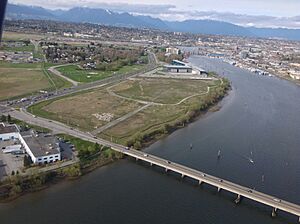
Two major highways serve Richmond. Highway 99 connects to Interstate 5 at the US border. Highway 91 connects Delta, New Westminster, and Richmond.
Railway bridges connect Lulu Island to Vancouver, New Westminster, and Annacis Island. These serve the Canadian National and Canadian Pacific Railways.
Public transportation is provided by TransLink. This system offers bus and rail service. It connects Richmond to Vancouver, Surrey, and other nearby cities. The Canada Line is a SkyTrain line. It connects Richmond and the airport to Downtown Vancouver. It opened on August 17, 2009. The Canada Line takes about 25 minutes to get to Downtown Vancouver. It runs every 3 to 12 minutes, 20 hours a day.
Major transit hubs include Richmond–Brighouse station and Bridgeport station. These are main stops for many bus routes. After the Canada Line closes, the N10 Nightbus provides late-night service.
A bike-sharing system with e-bikes and e-scooters started in the City Centre in May 2022. It is run by Lime.
Vancouver International Airport (YVR) is on Sea Island, part of Richmond. It is the main airport for the region. Several float plane companies also operate from the south terminal. They offer flights to the Gulf Islands and Vancouver Island. The airport is the second busiest in Canada.
Health Care Services
Health care in Richmond is managed by the Vancouver Coastal Health Authority. This authority also covers Vancouver and North Vancouver.
Richmond Hospital is being redeveloped. In 2018, plans for an 8-floor acute care tower were approved. On July 2, 2020, the government announced an updated plan. It includes a 9-floor tower with an expanded emergency room and ICU. Renovations to the south tower will add more mental health beds.
Richmond is known as the headquarters of the Canadian Hemochromatosis Society. This group helps people with a condition called hemochromatosis.
Emergency Services
The Richmond Fire-Rescue Department started in 1897. It provides fire and rescue services. The department has seven fire halls. They respond to fire calls and medical emergencies. They also provide emergency services at Vancouver International Airport. Fire stations are in City Centre, Steveston, and other areas.
The City of Richmond uses the Royal Canadian Mounted Police (RCMP) for law enforcement. Their main office is on No. 5 Road. The Richmond RCMP also has smaller community police stations.
The British Columbia Ambulance Service provides emergency medical help to the city.
Education in Richmond
Richmond has campuses for several universities and colleges. These include Kwantlen Polytechnic University, Sprott Shaw College, and Trinity Western University. The British Columbia Institute of Technology has an aerospace campus on Sea Island.
School District 38 Richmond manages 10 public high schools and 38 public elementary schools. This includes Montessori schools and French immersion schools. The district also offers two International Baccalaureate programs. These are at Richmond Secondary School and Hugh Boyd Secondary School.
The Conseil scolaire francophone de la Colombie-Britannique operates one French-language elementary school in Richmond. It is called école des Navigateurs.
Richmond also has private schools for K-12 education. Some examples are Richmond Christian School and St. Paul's Elementary School.
Media and Entertainment
Radio Stations
The Indo-Canadian radio station Sher-E-Punjab has its main office in Richmond.
Two Chinese-Canadian radio stations are also based in Richmond. They provide news, traffic, and music. Fairchild Radio is in Aberdeen Centre. It has programs for both Mandarin and Cantonese speakers. CHMB AM1320 is for Cantonese speakers. It is located in East Richmond.
Z95-3's studio is in the Ironwood area of Richmond. This radio station plays a mix of older songs and current hits.
Filming Locations
Steveston Village has been a filming location for many movies and TV shows. These include Blade II, The 6th Day, and The X-Files. It was also used for Supernatural and Smallville. Steveston is also the setting for the fictional town of Storybrooke in the ABC TV series Once Upon a Time.
Fantasy Gardens (an old amusement park) was used as Halloweentown in the Disney Channel movie Halloweentown II: Kalabar's Revenge. It also appeared in Stargate SG-1.
The outside of the Workers' Compensation Board building was used as a hospital in Stephen King's Kingdom Hospital.
Vancouver International Airport on Richmond's Sea Island has been in many films and TV shows. It often pretends to be Seattle-Tacoma International Airport. It has also been used in movies like Final Destination and The Sisterhood of the Traveling Pants.
The Aerospace Technology Campus of BCIT was used for filming Halo 4: Forward Unto Dawn. Other films like Rise of the Planet of the Apes were also filmed there.
Richmond is also the Vancouver headquarters for the Fairchild Media Group. They broadcast Cantonese and Mandarin television channels from Aberdeen Centre. Their channels include Fairchild TV and Talentvision.
Sister Cities
Richmond has "sister city" relationships with other cities around the world:
- Pierrefonds-Roxboro (Montreal), Canada (since 1967)
- Wakayama, Japan (since 1973)
- Xiamen, China (since 2012)
Since 2008, Richmond also has a friendship city relationship with Qingdao, China.
Notable People from Richmond
- Aaron Ashmore, actor
- Shawn Ashmore, actor
- Sonny Assu, artist
- Arjan Bhullar, wrestler
- Edison Chen, Hong Kong entertainer
- Nicki Clyne, actress
- Charlotte Diamond, children's singer
- Evan Dunfee, race walker and Olympian
- Gary Fung, founder of the BitTorrent site isohunt
- Shaul Gordon (born 1994), Canadian-Israeli Olympic fencer
- David Grierson, radio host
- Kyle Hamilton, Olympic rower (Gold medal)
- Scott Hannan, former NHL hockey player
- Rick Hansen, disability activist and Paralympian
- Chris Haslam, professional skateboarder
- Rob Howard, politician
- Olga Ilich, former British Columbia MLA
- Manny Jacinto, actor
- Brian Johns, Olympic swimmer
- Jason Jordan, former soccer player
- Helen Kelesi, professional tennis player
- Alexa Loo, Olympic snowboarder
- Harvey Lowe, first World Yo-Yo Contest winner (1932)
- Megan McNamara, beach volleyball player
- Nicole McNamara, beach volleyball player
- James Paxton, Major League Baseball player
- Angus Reid, former CFL football player
- Coco Rocha, supermodel
- Camryn Rogers, Olympic hammer thrower (Gold medal)
- Eli Schenkel (born 1992), Canadian-Israeli Olympic fencer
- Brent Seabrook, former NHL hockey player
- Bobby Singh, former CFL football player
- Troy Stecher, NHL hockey player
- Ryan Stiles, comedian
- Brittany Tiplady, teen actress
- Bjarni Tryggvason, astronaut
- Bill Vander Zalm, former Premier of British Columbia
Images for kids
See also
 In Spanish: Richmond (Columbia Británica) para niños
In Spanish: Richmond (Columbia Británica) para niños



